Sunday, April 14 2013
By now, most of you know that we have been working on a new, slightly faster trading model for over six months
- we are most pleased to officially introduce our new "MIPS4/MF+" model
- the name comes from: (a) MIPS4 to identify a new model, and (b) MF+ meaning medium-frequency "plus"
- MIPS4 is an offshoot of MIPS3, but uses algorithms from all MIPS models.
As with all of the MIPS models, with MIPS4 you can trade any ETF that "correlates" well with the SPY
- and, MIPS4 is a little smoother ride than MIPS3 (i.e., with less "volatility")
- as a result, the MIPS4 model produces very "smooth" results.
For this reason, we feel comfortable approving the use of MIPS4/MF+ signals to trade leveraged ETFs.
But, of course, you do NOT have to trade with leverage...
- if you do use leverage, however, we recommend double leverage long, but single leverage short for more
conservative use of leverage.
See the table below for the performance of all of the MIPS models in the time frame of 2003-3/31/13 .

In the graph below, we show MIPS4/MF+ as compared to MIPS3/MF.Improved and MIPS3/MF.org between 2006-03/31/13. M3.org (brown line) in the graph is the performance of the original MIPS3/MF model without the improvements made in 2011-2012.

DOUBLE LEVERAGE
The graph below shows MIPS4/MF+ trading double leverage SPY (SSO) on long signals and single leverage SPY (SH) on short signals. For more performance reports, click on the "Performance" tab on the main menu on our homepage.
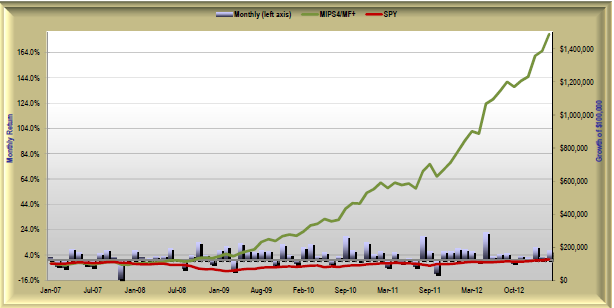
Monday, April 08 2013
It seems as though no one has a strong feeling for where this market will go from here. The market has hit all-time closing highs in the major indices and the retail investors (the "little guys") are rushing back into a market that they missed to the tune of over $100 billion in equities year-to-date. Other things affecting the market now are potential defaults in Greece and Cyprus, financial crises in the other PIIGS countries, interest in what the large institutional investors and retail investors will do next, interest in what the Fed will do next, etc. As always, a large number of issues/circumstances should determine the market's moves from here.
But, is this correct? One could make a strong case that the market behavior from here is not dependent upon the tens of thousands of institutional investors/traders or hundreds of millions of little guys, etc., but mainly on the actions of one man, Ben Bernanke, Chairman of the Federal Reserve.
Supposedly to stimulate the economy, Helicopter Ben has been printing tens of billions of dollars every month ($120B in 3Q'12 alone), with no end in sight. Our national debt rose by over $1 trillion last year, and we have more debt than all of the countries in the European Union combined. This will ultimately throw everything into chaos. At this time, the USA can only afford the interest payments on our national debt because Helicopter Ben is artificially keeping interest rates on mid- and long-term US Treasury bonds extremely low ("Operation Twist"). This, or course, drives bond prices up and overrides the normal reaction of bond prices to the economic outlook. Also, on the equity side, we have high quality companies borrowing money at record low interest rates to buy back their own shares, thus driving their profits in $'s/share higher due to a lower number of shares, even if their profits never changed. How long can this go on without serious consequences? By the way, what the Fed does is NOT subject to the authorization or approval of Congress or the White House (how did we let that happen?).
In his own words, Bernanke’s plan is to quit printing money only when unemployment falls to or below 6.5%. That is kind of like a family in serious debt borrowing more and more money until "things get better", even when the extra borrowing makes the “bad things" worse. How is that for "chasing your tail"? At no time in the past has any nation become more fiscally sound by taking on massive additional debt. Historically, this has only led to high inflation and/or bankruptcy.
In our case, large institutional investors will not sit tight and let this go on indefinitely with no repercussions. Ultimately they will react. Thankfully, MIPS followers do not need to "call the market" themselves. MIPS will follow the market movements (mainly from the big guys by tracking volume), and will follow the new trend. In the last 4+ weeks, the SPY has moved sideways after breaking its all-time closing high. Usually, the size of market moves after breakout from a narrow trading range is somewhat correlated to the longevity of the flat trading range. This market can go higher with QE3 and little guys coming back into the market, but it is going to be an uphill battle breaking above the SPY price of $157.5/share (all-time intraday high).
See the graph below. The market (SPY) has been moving sideways for the last 20+ days (purple rectangle). The pattern of the market during this time has been a series of sizeable drops on relatively high volume (big guys), followed by a complete recovery over the next several days on low volume (little guys). Last Friday, the bears made a gallant effort to put a substantial dent in the market including a down gap on the open followed by a triple digit drop in the Dow, but the bulls spoiled the party by buying it back up to (and a little above) the intermediate-term trend line (long green line).
It’s anybody's guess from here, so we will depend upon MIPS to detect the next meaningful trend and tell us what to do.
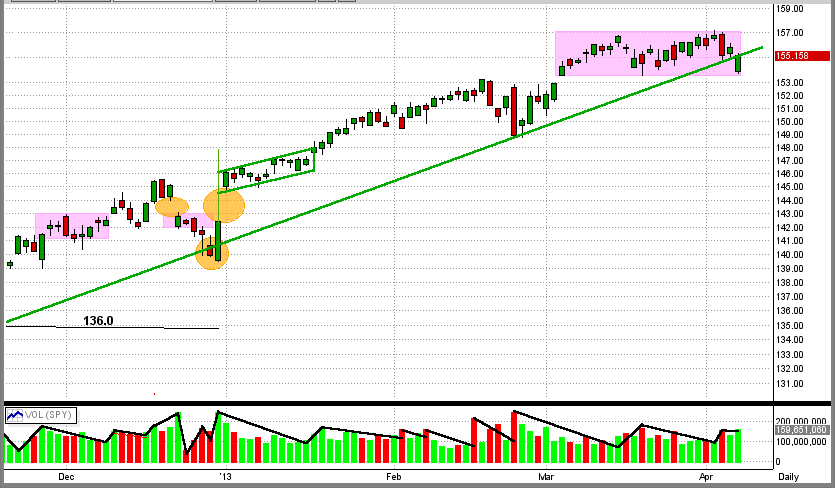
Sunday, March 17 2013
This bull market move is now facing its most daunting situation since 2009. We are fast approaching a point of "Stone Wall" resistance. This "Stone Wall", of course, is the all-time, intraday high for the SPY at $157.5/share on 10/11/07 (about $1565 on the S&P 500).
What makes this so "daunting" is that $157.5/share on the SPY now would complete a very precise, almost perfect 13-year "Triple-Top". See Graph #1 below (scary). If the SPY fails to break through this level to the upside (after a couple or three times), the results could be devastating.
Graph #1
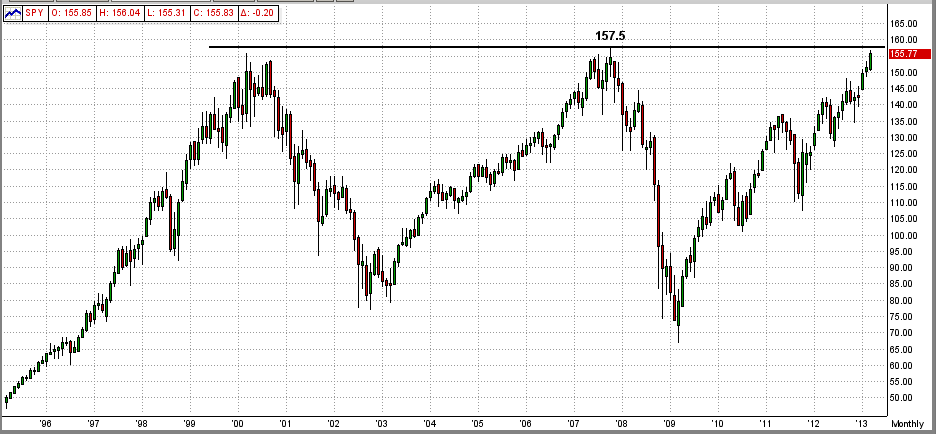
On the other hand, if the SPY does break through to the upside and stays above or goes higher, this could lead to panic buying (or according to Greenspan, "Irrational Exuberance").
For the last few months, the big guys have been selling on high volume and the little guys have been "buying the market" back up. See the volume numbers in Graph #2 below. Other than a couple of pretty weak "bear market traps" (which the MIPS models ignored) this market has been in a very obvious up-trend, and all of the MIPS models have been long since 11/21/12.
Graph #2
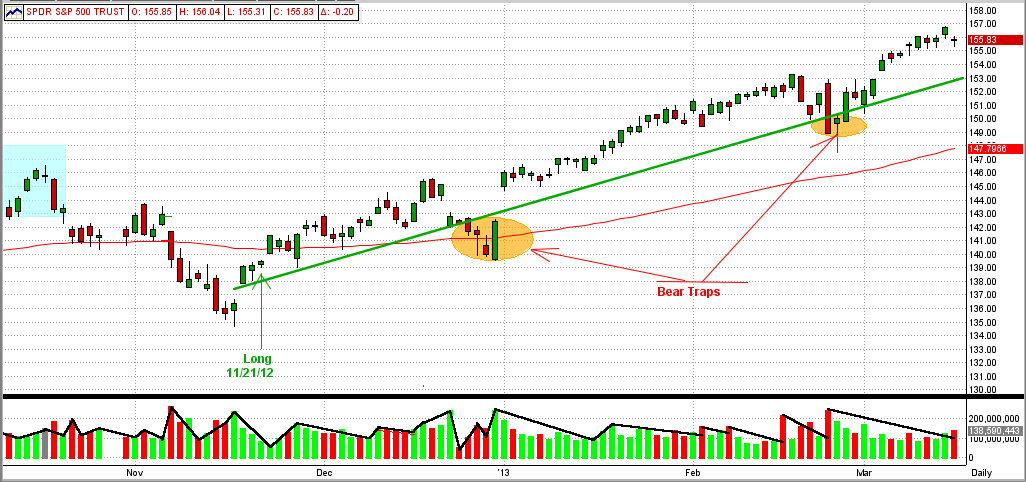 The little guy, big guy behavior
The little guy, big guy behavior above is a little nerve-racking, but remember that the little guys can come in en masse at market tops, and push it a lot higher (a la the NASDAQ in the late 1991's). See Graph #3 below.
Graph #3 (from Traders.com)
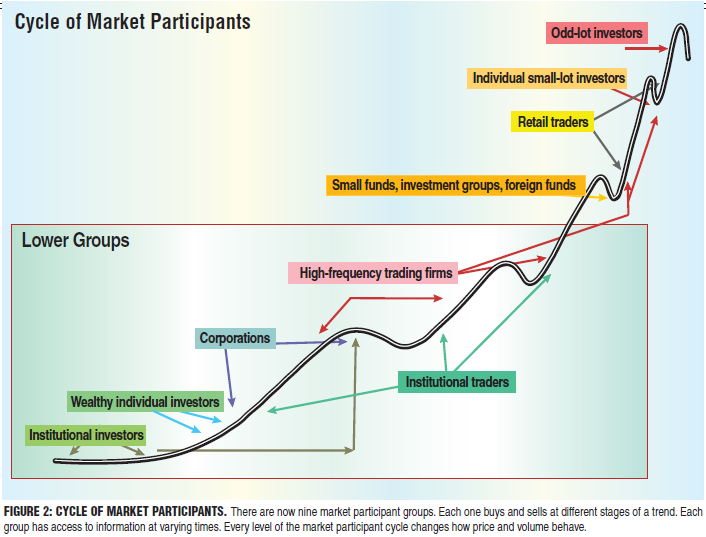
Good Trading !!!
Saturday, March 09 2013
From the outside, it would seem that this market should be going down. Most of the news from all over the world is bad news (or, at the very least, not good). But, the stock market keeps going up. With news like that below, how can this happen?
World News:

What others have to say (Jack's Wrap 3/08/13 - www.swingtradeonline.com)
" Once again, the market could find no sellers. The masses were thinking to sell the Jobs Report if it were good. Who can blame them since the market is so overbought. They were right. It sold. However, once it sold off some from the early morning highs, it was bought up once again. Not to the levels of the early day highs, but no real selling one would think likely after a strong early day pullback and still at overbought. The strength of this market is a bit strange, but you never fight the price action of the market. It speaks above all else. And, the bears have nothing. For crying out loud they can't even get a simple pullback going of 3-5% to unwind grossly overbought oscillators across all time frames."
OK, but that still does not answer the question as to why this market keeps going up. We think it is because the big guys have succeeded in sucking the little guys back into the market near its all-time highs and are hoping to have this turn into "hysterical buying" like in the tech bubble in 2000. We don't really think that anything close to the market behavior in 2000 will happen, but the little guys could easily push the market higher from here. If you look at daily price/volume graph over the last several months, you will see several days where the big guys really sold the market down (down on high volume) and then waited for (and watched) the little guys to push it ever higher (up on low volume).
At lease the big guys have succeeded in bringing the little guys back in the market after they missed gains from the bottom in 2009 of over 125% (see the top right in the graph below). [BTW, see where the big guys buy (bottom left).] In just the first two weeks of 2013, almost 20 billion dollars have moved from bonds and money market funds into US stocks and equity ETFs (Lipper). And guess what, that came from the little guys. See the graph below and you will realize that the little guys have been fooled again !!! They are buying at or near what could be the top (where retail/small investors almost always flock back into the market). The big guys will let the little guys push the market as high as the little guy wants, and then the big guys will dump en masse.
Let's rely on MIPS to keep us in the market on the ride up and get us out in time to make money in the downdraft (aka crash).
From www.traders.com

Monday, February 11 2013
Everyone pretty much agrees that this market is overbought, and most expect a pullback soon. Most likely, investors agree that the market is overbought, but all do not agree on what will happen from here.
When we look at the graph below, we can see that the SPY bottomed out at $134.7/share on 11/19/12 (MIPS3/MF went LONG on 11/23/12). Since then, the SPY:
(a) formed a new intermediate-term uptrend,
(b) broke the then recent triple top neckline at 143.0,
(c) fell into a short 5-day "bear trap" (purple box),
(d) gapped up and formed an up-pennant pattern,
(e) broke out of the up-pennant pattern to the upside, and
(f) formed a new, definitive uptrend.
The resulting performance from the SPY in this wild ride over the last 2-1/2 months is a healthy gain of 12.9%. And, this performance was not restricted to just the large-cap stocks in the SPY, as the Russell 2000 did even better. Of course, Apple put the brakes on the NASDAQ performance, but it was still up nicely.
The above is enough for most traders to declare that "the market" is overbought, at least in the short-term. It would be difficult for anyone to disagree with that. But, as always, there is another sneaky little option hiding in the numbers.
Looking a little closer at the volume during this run-up, we see that the market run-up has been on low volume. For example, the recent SPY volume has been only about 75% of its average volume. This decisively says that the run-up was the result of buying by the little guys rather than the big guys. And, I also believe that this is exactly what the big guys have been waiting for. If this keeps up, and if the SPY reaches or breaks its all-time high of $157.5/share from Oct'07, it could lead to euphoric buying by the little guys who missed the bull market of the last 4 years; thus pushing the market to record highs. Of course, this is exactly what the big guys want. THEN, they will dump their holdings at the very top one more time.
If you don't think this can happen, think again!!! To those who have not been trading for the last 15-20 years, this might not seem possible. But, I was right in the middle of Silicon Valley in the late 1990's when investors pushed Cisco System's stock price up to where its P/E ratio was 400 and Yahoo's market value was higher than the GDP of Iceland. What this shows is that it "is" possible for hyped-up buyers to push an already high, overbought market even higher.
This poses two very different outcomes (also see the take on this by the "pros" in the articles below).
Conclusion: Let's wait for MIPS to determine a new trend and tell us what to do.
Paul Distefano
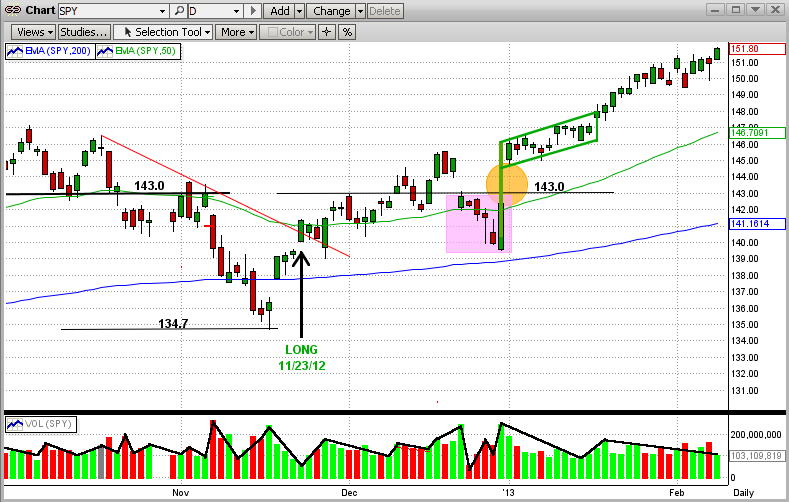
EXCERPTS FROM RECENT ARTICLES
---------------------------------------------------------------------------------------------------------------------------------------------
I. Is This the Death Knell for the Bull Market?
by Alexander Green, Chief Investment Strategist
Friday, February 8, 2013
www.investment-u.com
Well, it had to happen eventually. The average punter is finally returning to the stock market. TD Ameritrade registered an average 370,000 trades per day in January, up from 30,000 trades a day in December. And, according to data from TrimTabs Investment Research, investors funneled $55 billion into U.S. equity funds in January, the most ever for any month on record.
Of course, the big reason average investors are finally warming up to stocks again is: "They've been missing the boat".
Signaling a Top?
Last week the Dow closed above 14,000 for the first time since the financial crisis hobbled the global economy. Small investors - having missed out on the last 7,500 points - don't want to miss any more. Some analysts say the return of the small investor is a signal that the bull market, already nearly four years old, may soon give up the ghost.
Mutual fund flows also just turned heavily toward equities. Does that mean the end is near? History shows that small investors are only a good indicator at market extremes. They tend to be wildly optimistic at market tops and wholly pessimistic at market bottoms.
-------------------------------------------------------------------------------------------------------------------------------------------
II. JACK'S WRAP, Friday, February 08, 2013
Jack Steiman is author of SwingTradeOnline
www.SwingTradeOnline.com
The market continues to perform well overall, but as I have been saying for a while now, there is more and more risk. Just take a look at the weekly RSI's (Relative Strength Index) on the major index charts. While the Nasdaq is low in the lower 60's due its lagging mostly from Apple Inc. (AAPL), most of the other major index charts are just below 70, or actually at 70. When weekly charts get to 70 on those RSI's, it's not great news for the bulls. This does not mean the market will imminently fall hard, but you know it's not too far away. It's definitely out there.
If you look at markets historically, when the weekly RSI's get to 70 on the major index charts, it's prone to selling. The weekly charts are powerful, so, at least, take the time to notice what's happening with sentiment on these charts and play appropriately. Now, even though there are red flags, this doesn't mean you run for shelter automatically and sell everything on the long side. There are some great stock set-ups, and yes, it's harder to get them to do what we'd like as fast as we'd like, but many stocks are performing well and set up to do so in the weeks ahead, overbought weekly charts or not.
Tuesday, January 29 2013
This blog post is all about "Is This Market Rally Going Higher?"
- it is not about whether or not this market should go higher, and that is a big difference.
Almost any news can change the short-term direction (days/weeks) of the market, but only strong buying or selling volume can keep a trend going intermediate-to-long-term (like weeks/months). The four cycles in the long-term ups-and-downs in the market are something like that below:
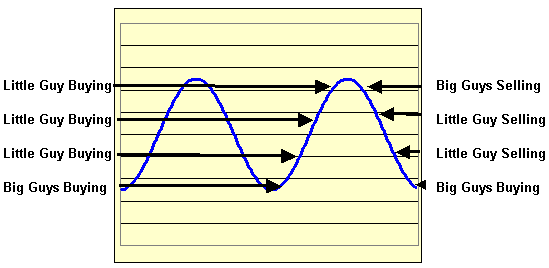
The steps in recovering from a bear market are (see the steps on the left side of the graph above):
1) the big guys buy at the market bottom (remember, they cause the bottom, not call it)
2) aggressive little guys who sold low, then sell their bonds and get back into equities when they
are still low
3) average little guys who sold about halfway down, also move money from bonds and get back
in the market
4) conservative little guys (who swore off the market), cave in and buy near the top (again and
again).
The steps after a long up market (like now) are shown below (also see the steps on the right above):
1) after the little guys have 80+ percent of their assets invested in equities, the big guys start a
stampede down
- we are not there yet, because the little guys have plenty of buying power tied up in bonds
- the SPY now is about $150.7/share and the all-time high from Oct'08 is about $157.5/share
- we believe that the big guys will let the little guys push the market to the all-time high (and
maybe higher)
- the big guys, of course, will be trying to start "panic buying" from the little guys near the top
- in reality, the big guys are not calling the market top, they are causing it
2) after the SPY makes new highs and the market gets even more "overbought", the big guys will
"dump"
3) the big guys' heavy selling will cause a big downside jolt in the market and the little guys will run
for the sidelines
4) as the first wave of little guys sell the market lower, more little guys will sell in stages all the way
to a new bottom.
In essence, we do not believe that the big guys will let this market "crash" until the SPY has "tested" its all time high at $157.5/share This might not happen until we have a small pullback, but we do think it will happen. And, we think there is a good chance that the little guys will push it that high, OR higher. But, we also believe that a big drop is possible (even likely) after that.
Either way, MIPS will catch the new trend and get us on the right track !!!
Thursday, January 24 2013
The title of this email was borrowed from an article on CNBC. And, remember my blog post from last week? ("Tipping Point for the Market in 1Q'13!") Well, it's all about that. The market (SPY) has gone up almost every day since the beginning of the year. And, the SPY broke its "up pennant" pattern decisively on 1/18/13. It seems to be headed for the SPY all-time high of $157/share (or about $1,570 on the S&P 500), made on 10/11/2007. Of course, we can expect extreme resistance at $150 and above, as the bulls and bears fight it out.
The SPY crossed $150 today, but was beaten back by the bears right around the $150 mark (and almost created the dreaded "one-day key reversal pattern"). Some say the bulls are determined to move the SPY up to test the all-time high and others say the market is way "over bought" and overdue to fall back. See excerpts of what CNBC says below the graph.

Thursday, 24 Jan 2013 | 10:36 AM ET
The Standard & Poor's 500 crossed the last big, round number between here and a record high, a destination considered inevitable by some Wall Street pros. Early Thursday trading saw the S&P 500 briefly pass through 1,500, just 65 points shy of its 1,565 record set in 2007.
Dan Greenhaus, BTIG; and Scott Sperling, THL Partners, discuss the market's recent rally and provide an outlook on private equity. While many traders usually dismiss the big, round numbers as having little meaning from a fundamental or technical standpoint, eclipsing this mark could be different.
"It's psychological more than anything," said Justin Wiggs, vice president of trading at Stifel Nicolaus. "If we stay above 1,500 it could bring some incremental dollars off the sidelines." The move past 1,500 comes as investors have been showing more confidence in stocks, finally taking some of the $2.7 trillion lying dormant in low-yielding money market funds and pumping it into equities. Stock-based mutual funds saw $9.3 billion of inflows last week and $23.6 billion over the past two weeks, according to the Investment Company Institute.
The 1,500 billboard could become just a signpost along the way if current chart patterns hold up. "We're already confirmed to go maybe not exactly to the all-time high but pretty darned close," said Abigail Doolittle, technical strategist at Seaport Group in New York. That trading behavior has been significant within the context of the Federal Reserve's liquidity programs. The central bank has pumped nearly $3 trillion through its government debt-buying program known as quantitative easing, or QE.
Doolittle has issued bearish calls in the past and still believes the long-term picture of the stock market is troubling, but sees Federal Reserve liquidity driving the market now. "It's going to be interesting to see how this plays out. It's unbelievable that the Fed has been able to pull this off," she said. "I applaud them because it hasn't collapsed yet, but I'll be shocked if there's not some severe market action to the downside, very similar to 2000 and 2007."
While the round number are often dismissed, they can prove formidable barriers. The S&P 500 struggled for three months in 2012 to clear 1,400, but once it did the average zoomed higher. "If it was the first time we were hitting the big, round number it could represent resistance. We've already been through there a couple times," said Mark Arbeter, chief technical strategist at S&P Capital IQ. "The completion of some chart formations suggests we could have measured moves back up towards the all-time highs in the first quarter."
"This is a very frustrating market," said Kathy Boyle, president of Chapin Hill Advisors. "It's times like this when I feel like throwing in the towel. That's when I feel like I should stick to my guns."
"end..."
Thursday, January 17 2013
It looks like we are at a "Tipping Point" in the market for 1Q'13. Let's look at the performance of the SPY since 12/31/12. We received an overdue Christmas present on 12/31/12, as the SPY roared up over 2% on that day. On the first trading day of this year (1/02/13), the SPY "gapped up" and closed even higher on this day's close at 146.06. Overall, these two trading days accounted for a total gain of about 4.7%, with high volume on both days!!! Thanks for the good start, big guys.
Since then, the SPY has formed a classic "up flag" pattern, but on low volume (the big guys letting the little guys push the market even higher). Today we almost saw an impressive break of the SPY to the upside of this pattern, but instead the SPY closed at or near the top of this pattern's upper range at $148.0/share. By the way, this is above the 4-year high for the SPY of $146.99/share on 1/02/08. If we break out of this pattern decisively to the upside, we believe that we will see new all-time highs for the SPY (and other indices) in the first half of 2013.
[My opinion, and my opinion only, is that the big guys (Goldman Sachs, etc.) will let the little guys (those of us with less than $20 million) push the market to all-time highs. And, just about when all of the little guys have 80-90% of their portfolios in equities, the big guys will sell the market down big-time. BTW, I developed MIPS to help me trade with quantitative analysis rather than with my opinions, and MIPS has been very, very successful on that issue.]
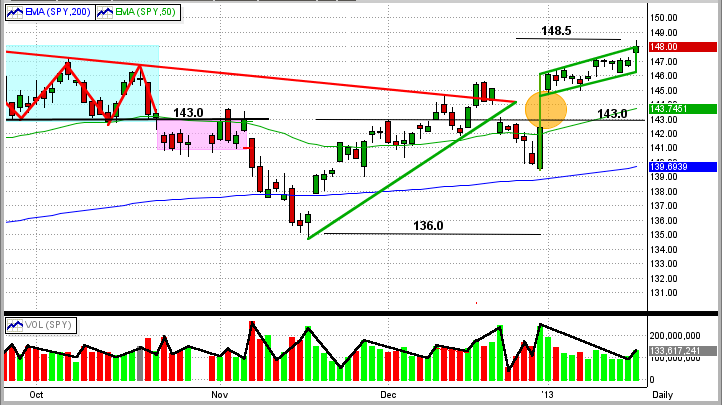
Wednesday, January 09 2013
Our flagship MIPS3/MF model did NOT do really well in 2012. Our portfolio managed by MIPS3/MF trading
SPY long and short was up about 8.5% for the year (9% counting dividends earned and commissions
paid), versus about 13% growth for the SPY. So, what can we do to perform better?
Here are three ways to do better using the MIPS3/MF model (at least they have been better over the last 7 years).
Improvement #1 - Trade Multiple ETFs
As most of you know, our MIPS models are tracking the ETF for the S&P500 Index (SPY), because we
believe that the S&P500 is a very good representation of "the market". For this reason and this reason
only, we report our performance of MIPS models trading the SPY.
However, as you most likely know, MIPS members are not restricted to trading just the SPY. In fact, as
you can read under the "Services" tab on our homepage, MIPS members can trade any ETF that
"correlates" well with the SPY (or any mix thereof). Most of he ETFs that represents the major USA
indices (SPY, MDY, IWM, QQQ), fill this bill. See the definition of "correlates" at Investopedia.com:
http://www.investopedia.com/terms/c/correlation.asp#axzz2HRqpl6YI )
Therefore, if so desired, MIPS investors can trade the following:
I.) Conservative investors trading SPY long and short (or buying SH on shorts).
II.) Aggressive investors buying 1/3 each of SPY, IWM, QQQ on long signals, but only
shorting the SPY on short signals (or buying SH).
III.) More Aggressive investors buying 1/3 each of SPY, IWM, QQQ long and either shorting
these ETFs or buying their corresponding inverse ETFs on short signals (SH, RWM, PSQ).
BTW, I usually apply profile "II" or "III" above to my trading.

So, in the last 3 years 2010-2011-2012 (certainly not the best time for MIPS3/MF), when the SPY with
buy/hold was up 28%, MIPS3/MF trading just SPY (using profile "I") was up 42% (not at all bad). But,
trading with profile "III" in this time period, MIPS3/MF would have been up a whopping 58% (tons better
than the 28% with buy/hold, and also better than 42% from trading just the SPY with MIPS3/MF).
If we look at the last 7 years (longer-term view), the SPY was up 14%, and the trading profile "III" with
MIPS3/MF would have been up 379% (verified by TimerTrac.com) !!!
Improvement #2 - New "Improv" Release
This one is on the house. The performance of the current MIPS models are some of the very best in
the industry. However, as most of you know, we at MIPS are continually trying to make our models
even better.
To that end, we recently updated some of the algorithms in our models to respond more effectively
in flat or sideways market (like the markets in 2011-12), and hence these MIPS models will do a lot better
in these types of markets in the future. This, of course, will improve the overall results of all MIPS models
going forward.
Please note that these are NOT NEW models, they are simply the old models with relatively simple
but very effective revisions. When we develop a completely different model, the name of the new
model, or course, will definitely be different from that of any existing models (as in MIPS3/MF versus
MIPS2/LF).

Improvement #3 - Trading Leveraged ETFs
Investors who are willing to take more risk would most likely do better with the MIPS3/MF model trading
"double leveraged" ETFs. I personally do not like to trade leveraged ETFs on every trade. Sometimes
I do use double leveraged SPY on long signals, but I use single leveraged SPY on short signals. The
results of using MIPS3/MF signals with this trading strategy are shown below (from TimerTrac.com).
In the 7-year period of 2006-12, MIPS3/MF trading single leveraged SPY was up 314% (left graph); but trading
double leveraged SPY on long signals and single leveraged SPY on short signals would have produced gains of
about 700% (right graph). Please pay close attention to the vertical axis in both graphs below.
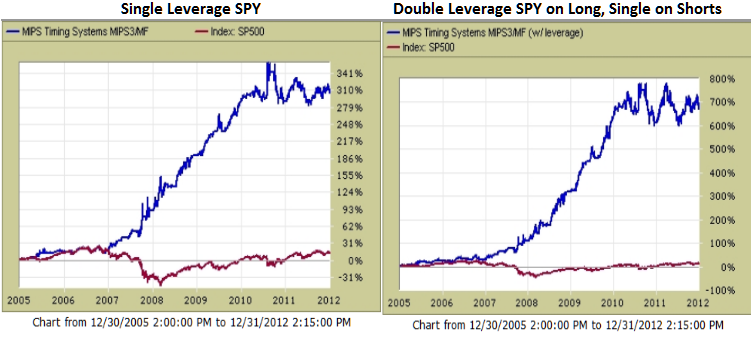
Thursday, December 27 2012
We got a real scare in the market today as the stock market fell more than 1% after Senate Majority Leader Harry Reid said that is unlikely that a deal could be reached in Congress before the Dec. 31st "deadline". This made us revisit our thoughts that we may be on a downward path in an eerily similar fashion to that in 2007-08 (see the graph immediately below and the first graph in our "Previous email"). Had the rapid fall continued, this could have been a grim day for the bulls. It is good to note that the pullback of the last 4 days has been on low volume.
On the positive side for the bulls, the SPY experienced what could prove to be a "one-day key reversal" where the market drops dramatically on a day following a short-term pullback, but recovers and closes above or near its open on that same day. Also positive is that the SPY broke its 100-day EMA, but recovered and closed above it (blue dotted line). Of course, this DOES NOT MEAN that the downward move is over, but it is a good sign.
We all know that the market's next short-term move is going to depend upon any progress (or lack thereof) in the negotiations in Congress regarding taxes and spending cuts and whether concrete progress is apparent in avoiding going over the "Fiscal Cliff".
It is impossible for any of us predict the outcome of these negotiations, so we will have to wait until these negotiations progress (or stall), and let MIPS decide what we should do.
Stock Market Crash of 2012 ???
 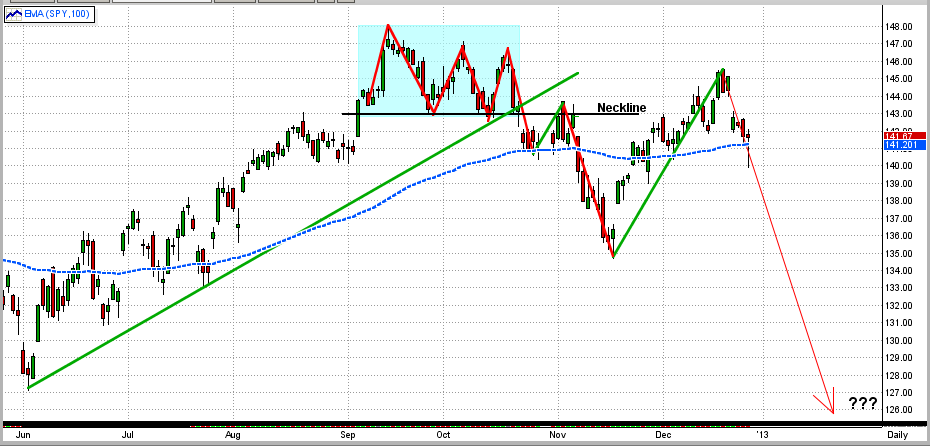
|